The Kernoghan Family
Samuel Kernoghan was the son of Henry Kernaghan, occupation: labourer, and Rebecca McKay Kernaghan. Rebecca died before 1888, Henry after. We are assuming they lived in Ireland. In 1891, Samuel who was born in Ireland about 1848, was listed in the Census as sugarhouse laborer. According to the Greenock librarian, many Irish came over to Scotland at this time to work in the sugarhouses. It was apparently terrible work that many of the local people did not care to do.
It appears that Samuel brought two children with him when he emigrated to Scotland. His son, Henry Kernoghan who was born in 1867 in Ireland, is also listed as a sugarhouse laborer, and a daughter, Agnes Kernoghan born abt. 1869, also in Ireland. Agnes, then aged 22 is listed as unmarried and working as a knitter in a mill.
Mary Ann Miller was the mother of Samuel's children Henry and Agnes. She died, (we believe), in Ireland before the family came to Scotland. (Mary Ann must have passed sometime after 1869, but before 1888. We do not know when Samuel emigrated.) The 1891 census lists Samuel's wife as Jane Kernoghan. Their Register of Marriage says that Samuel and Jane were married on October 6, 1888, After Banns, in the Church of Scotland. At the time of their marriage, Samuel was 40 years old and living with his 21 year old daughter Agnes, and 19 year old son Henry. Jane was 33 with sons John, age 11 and Robert, 9 years old. Samuel's address at the time was 8 Nile Street, Greenock, Jane's was 10 Nile Street so we assume they met as neighbors. The combined family went to live in Jane's flat.
Jane was age 36 in 1891, only twelve years older than Samuel's son Henry. She is listed as born in Renfrewshire. Her parents were James Hunter, Quay Labourer, and Mary O Donnell Hunter (both deceased in 1888). Jane apparently had been married to a Mr. Shirley before Samuel. Her two sons, John Shirley, age 14 also a sugarhouse laborer, and Robert Shirley, age 12 a "scholar", lived with the family as well. Sent for Extract of John Shirley. Hope to get date of birth and name of father. How long was Jane widowed before she remarried?
By the 1891 Census, we know the family address was still "10 Niles Street, Greenock, Scotland". This was an apartment building with at least two other families living in it. The Kernoghan apartment is did not have any windows.
It is also interesting to note that in addition to the address, name, relationship, condition as to marriage, age as of last birthday, profession, and where born, the census also asked if the respondent spoke Gaelic or Gaelic and English, Whether they were 1. Deaf and Dumb, 2. Blind, 3. Lunatic, Imbecile, or Idiot, and if the family had any rooms with one or more windows. The Kernoghans responded that they spoke English, were not Imbeciles and had no windows. Except for the windows, we hope we can still say the same!
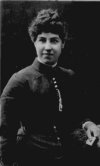 Agnes Kernoghan Adams
This photo was a "Carte Postale" with the inscription "Mother" and "To: Sis Agnes
From: Bro John". Based on the inscription, we believe that this is a picture of Granny
Hamill's mother, Agnes Kernoghan Adams (1869-1907). She was married to William Adams on March 3, 1893, "After Banns" in the Augustine Church, Church of Scotland in Greenock.
William Adams
(Protestant,), was born in 1869 to parents John
Adams, Labourer and Margaret Ann Campbell Adams. His address at the time of their wedding was 60 Ann Street, Greenock. Agnes was married from her family's home at 10 Nile Street. They were both 24 years old. Note: Robert Kernoghan was the one of the Witness', it is not known if he was a relation of Agnes.
Agnes Kernoghan Adams
This photo was a "Carte Postale" with the inscription "Mother" and "To: Sis Agnes
From: Bro John". Based on the inscription, we believe that this is a picture of Granny
Hamill's mother, Agnes Kernoghan Adams (1869-1907). She was married to William Adams on March 3, 1893, "After Banns" in the Augustine Church, Church of Scotland in Greenock.
William Adams
(Protestant,), was born in 1869 to parents John
Adams, Labourer and Margaret Ann Campbell Adams. His address at the time of their wedding was 60 Ann Street, Greenock. Agnes was married from her family's home at 10 Nile Street. They were both 24 years old. Note: Robert Kernoghan was the one of the Witness', it is not known if he was a relation of Agnes. William and Agnes Kernoghan Adams are known to have had four children. John, Robert, Margaret, and Agnes Adams. Agnes Kernoghan Adams died about 11 weeks after the birth of her last child, also called Agnes. The register of her death states that she was 38 years old and married to William Adams who at the time was working as a Shipyard Labourer. Their address was 27 Roxburgh Street, Greenock. She died on June 26, 1907 at 11:30 am of Heart Failure (Sudden Death). We suspect that she developed a blood clot after giving birth that may have broken away and caused her sudden death. It is not entirely clear what happened to the children after Agnes' death. Somehow, the boys ended up in an Orphanage. We have no idea what happened to Margaret. The baby, Agnes might have gone to live with some relations. William Adams was still alive in 1945.
Of the four children, John Adams, was a career soldier in the The Argyll and Sutherland Highlanders (Princess Louise's) Regiment. The picture (at right) was taken in Heluan, Egypt (John is the chap with the pipe.), so we are guessing that he was in the 1st Battalion "which served in India from 1919 until 1923 and then Egypt and Sudan from 1925 until 1928 followed by eleven years at home. At the outbreak of war they had moved to Palestine." The regiment was based at Stirling Castle.
 John Adams seems sort of larger than life. He was born in 1902. Family lore says that he joined the army to escape the orphanage at age 14. He traveled the world as a soldier. At some point, (before 1929), he came to Port Glasgow to search for his youngest sister Agnes, and actually met her on a blind date set up by one of his friends. John was also "busted" down in rank for helping his brother Robert elope with the Sergeant Major's daughter.
John Adams seems sort of larger than life. He was born in 1902. Family lore says that he joined the army to escape the orphanage at age 14. He traveled the world as a soldier. At some point, (before 1929), he came to Port Glasgow to search for his youngest sister Agnes, and actually met her on a blind date set up by one of his friends. John was also "busted" down in rank for helping his brother Robert elope with the Sergeant Major's daughter.  Thanks to the research of Nancy Byng Pilat, we know that on December 22, 1939, John Adams married Agnes (Nessie) Byng, daughter of Thomas. C. Byng and _________. At that time John was Company Sergeant-Major John Adams of the 10th Battalion, Argyle and
Sutherland Highlanders.
Thanks to the research of Nancy Byng Pilat, we know that on December 22, 1939, John Adams married Agnes (Nessie) Byng, daughter of Thomas. C. Byng and _________. At that time John was Company Sergeant-Major John Adams of the 10th Battalion, Argyle and
Sutherland Highlanders. In August of 1942, Nessie gave birth to a son, John W. Adams, who died a week later on August 20, 1942. John Sr. and Nessie were living in Greenock after WWII. John went to visit Nessie's brother William Byng in Canada in 1948 to check out job prospects, but returned to Greenock. He apparently died from a heart attack November 8, 1951 at the age of 49, possibly in his Rifle Club. We have written to the Govt. to try to get his military records. Nessie lived in Greenock until her death from a stroke in 1976. John, Agnes, and their little son are all burried in Greenock Cemetery next to the Byng family (Lair 63, Class 8, Section B Recess).
Robert Adams, known as "Wee Bobby", was also a soldier for a time in the same regiment as his brother John. He had a wife "Minnie" and son "Willie" and settled in London. Lore says that Minnie was the daughter of his commanding officer. It is not clear if their son William "Willie" Adams was born in Scotland or England. Bobby and Minnie had Scottish accents, and Willie is said to have had a very Cockney English accent. In 1954, the family lived in Shepherds Bush, London. At that time, Willie was around 22 years old, putting his birth about 1932, and living with his parents. We know that Willie eventually married a very pretty English girl who's name is not known.
Not much is known about Margaret Adams (pictured at left), except that she was born before 1907 and is also believed to have been raised in an orphanage.
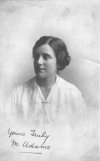 It is known that Margaret lived and died (probably in the 1930's or 1940's) in Greenock, Scotland. We do not know if she was in contact with her brothers, but sadly, she never met her youngest sister Agnes.
It is known that Margaret lived and died (probably in the 1930's or 1940's) in Greenock, Scotland. We do not know if she was in contact with her brothers, but sadly, she never met her youngest sister Agnes.
The youngest child, Agnes Adams (Granny Hamill) was born on April 3, 1907 at 8 a.m. at 27 Roxbrugh Street, Greenock. See picture at right. (She was raised by ??? She met James Joseph Hamill ????? Where she lived, where she worked.)
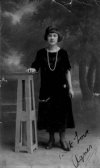 At the time
of her wedding, Agnes Adams father, William Adams was still alive. (Did he remarry? Where did he live? When and where did he pass?
) Their witnesses were Augustine Doherty of
Port Glasgow and Jane McMeiken of Greenock
At the time
of her wedding, Agnes Adams father, William Adams was still alive. (Did he remarry? Where did he live? When and where did he pass?
) Their witnesses were Augustine Doherty of
Port Glasgow and Jane McMeiken of GreenockThe details of Agnes Adams early life are very sketchy. It is interesting to note that she is the only one of the four children who was Catholic. She was baptized when she was about a year old, so she must have been living with a Catholic family at that time. It seems that she was moved around a lot as a young child. She once mentioned working in her Italian Aunt's Sweet Shop.
Lore says that when she was 15, she was in need of a place to live and the Parish Priest approached Mr. and Mrs. McMenemy who were also caring for their young niece Mary McMenemy. Before accepting her, they felt they needed to meet Agnes in person. After the meeting, the Priest is said to have asked Agnes what she thought of the family and she responded "I like that wee lassie! referring to young Mary. Augustine "Old Gus" McMenemy took Agnes into his home and gave her the first stable home she knew. She was very fond of him and remained close with their niece Mary the rest of her life.
The Hamill and Dunn Families
Click on maps to see a larger image
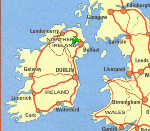

His birth extract says that James Joseph Hamill was born on June 12, 1902 at 5pm at 77 Balfour Street, Port Glasgow. His birth was registered by his father John Hamill on June 16, 1902. John Hamill's occupation at the time is listed as "Iron Driller". James' birth certificate also states that John Hamill married Bridget Dunn on September 16, 1901 in Port Glasgow, Scotland.
Bridget Dunn was born October 29, 1882 at 12 noon at 23 Balfour Street, Port Glasgow to Joseph Dunn, Shipyard Labourer and Isabella Gorry Dunn. Bridget's parents were married on January 1, 1882 at St. John's Catholic Church in Port Glasgow. Joseph, was the son of James Dunn, Shoemaker and Bridget Foster Dunn (deceased), and Isabella, the daughter of Neil Gorry, Sawmill labourer and Nancy M(c) Laughlan Gorry. The 1891 Census states that both Joseph and Isabella were born in Ireland. At the time of their marriage, Joseph was 24 years old and working as a Shipyard Labourer. Isabella was also 24 years old and her occupation is listed as Mill Worker. They both lived on Balfour Street, Port Glasgow.
There were at least five apartments at 23 Balfour Street. At the time of their marriage (1882), both Isabella and Joseph listed "Balfour Street" as their address. We assume they may have met as neighbors. In addition, Isabella's brother Niel Gorry and his family are listed as living in the same building in the 1891 Census.
Bridget was the oldest(?) of six known children born to Joseph and Isabella. The children were Bridget (b. 1882), Neil (born. abt. 1884. He registered his father's death in 1902), Catherine (born abt. 1887), James (born abt. 1889 and believed to have died in childhood), Joseph Dunn (b. 1890), and Maryanne.
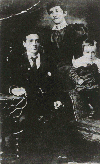 James' mother, Bridget Dunn Hamill, died September 27, 1903 at her home on 23 Balfour Street, Port Glasgow. The cause of death was "Phthisis Pulmonalis" which is Tuberculosis of the lung, which she had suffered from for three months.
Her death certificate says that she was 19 at the time of her passing, but her birth certificate indicates she was a month away from 21.
Her son James, was about 15 months old. The picture of the family at left is noteworthy because Bridget Dunn was already
deceased when the photo of her husband and son was taken. They had her image put in.
James' mother, Bridget Dunn Hamill, died September 27, 1903 at her home on 23 Balfour Street, Port Glasgow. The cause of death was "Phthisis Pulmonalis" which is Tuberculosis of the lung, which she had suffered from for three months.
Her death certificate says that she was 19 at the time of her passing, but her birth certificate indicates she was a month away from 21.
Her son James, was about 15 months old. The picture of the family at left is noteworthy because Bridget Dunn was already
deceased when the photo of her husband and son was taken. They had her image put in.
Family lore said that after the death of his mother, James was sent to live with her parents Joseph Dunn and Isabella Gorry Dunn in Ireland (?). But Joseph Dunn died in on September 20, 1902 at age 44 in Port Glasgow. It is interesting to note that he also died of Tuberculosis of the Lung, which he had suffered from for 4 months, and his address was the same as his daughter, Bridget Dunn Hamill. Maryann Dunn who married (?)McGachy and lived in Port Glasgow, Scotland(?). Kate Dunn who married (?) McInulty. Their brother, Joseph Dunn, born 1890, married and had a large family in Port Glasgow. Dunganon, Ireland fits in somewhere with the Dunn family.
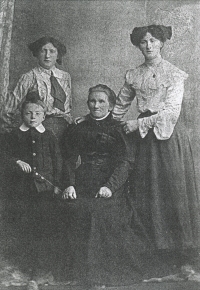 Picture is of young James Hamill with his Granny Isabella Dunn and two of her daughters. Picture taken around 1905. Family lore states that after James' grandparents in Ireland passed away (Not sure his Grandparents were ever in Ireland.), he came to live with his Aunt Maryann Dunn
McGachy in (?) Port Glasgow. Did Maryann have other children?
Picture is of young James Hamill with his Granny Isabella Dunn and two of her daughters. Picture taken around 1905. Family lore states that after James' grandparents in Ireland passed away (Not sure his Grandparents were ever in Ireland.), he came to live with his Aunt Maryann Dunn
McGachy in (?) Port Glasgow. Did Maryann have other children? Are there any Dunn relations still in the area(?) What happened to James' father John Hamill? Did he remarry? He died before 1929. Where did he live? Ireland or Scotland, when was he born, etc?
The Branches Meet
James was discribed as slim, medium height with blue eyes. Agnes was petite with brown eyes. James and Agnes had four children. John Hamill was born Sept. 23, 1929, Agnes Hamill was born November 1, 1930. James Hamill (Jim) was born Feb. 28, 1933, and Bridget Hamill was born October 25, 1937.
The family lived at 23 F Fore Street, across from the old harbor in the downtown Port Glasgow. James was often unemployed due to lack of work in the shipyards so money was scarce, but Jim fixed shoes, clocks and radios for family members. He was discribed as a "putterer". He and another fellow also went in on a pair of hair clippers and they took turns cutting their family's hair. His daughter Agnes rememberd that he loved to sing Irish and other songs like "The Old Bog Road" and "Delia". James Hamill also liked to read, mostly novels borrowed from the library or friends.
Food was a challenge for the family. In the morning, the kids ate "Baps", a type of roll with butter. Agnes recalled that they would often take a cheese and buttter sandwich to school for lunch. Typical suppers were soups to fill you up, especially lentil and potato soups, beef stew, tatties and mince, stovies, fish and chips (mostly from a chip shop), and on special occasions, steak pie. Read Agnes' memories of childhood during the Great Depression.
Agnes remembered that after their mother would put them to bed at night, they would each call out "Goodnight Mammie", first John, then her, then Jim, and then John would again say "Goodnight Mammie". They would go on and on like this, until they finally fell asleep, each trying to have the last word. This would drive their mother crazy.
The children first attended (Wee) St. John's school in Port Glasgow. Because of the depression and later the war, no one could afford uniforms, so this was not enforced during these years at St. John's. At the time, you could get "the belt" in school for offences like not doing your homework, or being late to class. "The belt" was a leather strap with tails. You would be summoned to the front of the class then the teachers would crack the student on the hands with it. Agnes remembered that sometimes the tails would wrap around your hands and had to be unwound before the next crack or release. She also said that the kids would never go home and complain about being punished, because you would "get it again" from your parents for needing punished!
Agnes remembers playing games after school with the other neighborhood kids, depending on the weather of course. Cowboys and Indians, Cops and Robbers, and Goodies and Baddies (Sheriff and Outlaws), were favorites. Agnes' favorite character was the exotic Cisco Kid. She used a black eyebrow pencil to draw on her mustache. The kids also found that they could fashion a tomahawk by taking an old soup can and putting a stick in it, then placing it in the road to be flattened by a passing car or truck. They also made their own bows and arrows.
Balls, hopscotch and jumpropes were popular pastimes as well. While jumping rope the kids would chant rhymes and songs. Song Sheets were also really exciting. These would have the words to all the new songs on the radio, no music, just the words so you could sing along.
Agnes remembers that her mother often had friends over "for tea" in the afternoon. She would hear the ladies laughing and telling stories and want to come in and listen. "Little jugs have big ears" her mother's friends would say and Agnes would be shooed out the house. These ladies had a lot of fun together in the afternoons.
Agnes also said that everyone in her family was fond of reading. Her father would read novels, fiction mostly. Her mother loved to read women's magazines like "My Weekly" and "Woman's Own". Her friends would pass them around to each other. Their Mother really enjoyed romance novels, she would get them from the library or borrow them from friends. Agatha Cristie was also popular in the family.
At some point during the depression, some of Jim's relatives, who were younger than him, came to live with the family. Jim Shirley, his wife Madge Dunn and their children Jim and Joseph Shirley had gone to England to look for work. They returned to Scotland with no where to live and were taken in my Agnes and Jim Hamill. The flat had only two bedrooms and one was vacated for the Shirley's. On occassion, Mrs. Shirley's father or brother would also stay over. It was really a cramped living arrangement. The Shirley's had a daughter after they moved from the Hamill's. Note: I believe the Shirleys were actually related to the Jim Hamill via his Grandad Samuel Kernahan who's second marriage was to Jane who was married to a Mr. Shirley first and had 2 sons with the last name Shirley. It is also possible that he was related to the Dunn's via Madge.
On September 3, 1939, the Hamill's were at home listening to the radio when Prime Minister Neville Chamberlain came on and said "I am speaking to you from the Cabinet Room at 10, Downing Street. This morning the British Ambassador in Berlin handed the German Government a final Note stating that unless we heard from them by 11 0'clock that they were prepared at once to withdraw their troops from Poland a state of war would exist between us. I have to tell you now that no such undertaking has been received, and that consequently this country is at war with Germany." Read the full text of the speech. Although everyone was expecting war, hearing the actual news gave 10 year old John "the chills".
The children were acquainted with many men who had been in WWI, which was only 21 years before the start of WWII. They and had heard many horrific stories and knew men who had been wounded or gassed.
The war was to be a blessing for the Hamill's financial fortunes. For the first time it was socially acceptable for women to work and there were plenty of jobs to be filled. During the war, Agnes worked in a munitions factory in Bishopton. There is a story about Agnes going into her work compartment and the wind caught the door and slammed it. At that exact moment there was a huge explosion in which other workers were killed. Agnes was very upset because she thought she caused it, but it was just coincidence. Rationing.
Agnes told a story about how she once saw tanks driving through the streets of Port Glasgow. She said it was very exciting for the kids because they had never seen anything quite like it. She remarked that the tanks were incredibly loud.
John remembered being fitted for his gas mask and having drills in school on how to use it. Agnes said that if you forgot your gas mask, an air raid warden or police officer would send you home to get it. She also quiped that by the end of the war when it was pretty clear that they would not be gassed, people use to carry all sorts of other items in their gas mask boxes.
Port Glasgow also complied with the national effort to completely "blackout" the town at night. Agnes said that if there was even a little pin hole of light showing through, the air warden would knock on your door and have you fix it. If there was a house with repeated infractions, the gossip was started that the inhabitants "must be spies."
Rumors of German spies were everywhere at that time. The government had raised awareness with campaigns including the "Mums the Word" and "Loose lips sink Ships" posters. Because of their relative location to the shipyards and the naval convoys, Port Glasgow and Greenock were important, and the thought of real spies gave the children, and plenty of adults, lots of fodder for their imagination (re word this.)
John, Agnes and Jim along with thousands of other children were evacuated to the country to escape the perils of bombing. Kim was so young she stayed with their mother. The three other kids went to live in Neilston in Lanarkshire. John and Jim were taken in by a lady and Agnes went to stay with this lady's grown daughter who lived in the same town, (possibly on Lee Street). While there, they attended St. Thomas' school. Agnes was miserable. The lady she was living with had three sons who would pinch and hit her, and Agnes was afraid to retaliate in case she was put out. Eventually, their mother came to get them. She said "If we die, we die together."
As they grew, the Hamill children graduated to St. Columba's school which is located up on a hill in Greenock. They would take the train from Port Glasgow then walk up to school. Agnes described the uniforms as "navy blue with a sash, white shirt and black shoes" for girls. She said that if you were really lucky you had more than one shirt, if you didn't, it meant that you had your shirt washed every night and it was sometimes tough to get it totally dry by the morning.
In those days, if a female teacher got married, she retired because married women didn't work. But so many of the male teachers had gone off to fight in the war that the married teachers were called back. In fact, one of their male teachers named Mickey Roden was captured by the Japanese and eventually died on one of the death marches.
From the school's vantage point, you could see the river Clyde and all the ships that came and went. John said that one week you would see the "Queen Mary" arrive, the next "Queen Elizabeth". Before Pearl Harbor, these ships brought in supplies, after America entered the war, the ships brought troops.
The U.S. troops would disembark in Greenock or Gourock and then take a train to Glasgow, then another train into England where they would make their way to the continent. All the children would line the train tracks and call to the service men "Got some gum, Chum?" and the like, and the soldiers would throw the children candy and coins. This was a really big thrill. Agnes rememberd that the parents and the police tried in vain to stop the kids, but since the ration of sweets was like 2 oz a week, it was impossible.
John also told the story of being in school when the teacher asked one of his class mates to close the window. At the exact moment the boy closed the window, there was a terrific explosion. The teacher said "You didn't have to close it that hard."
In fact the explosion was the beginning of a terrible tragedy. A French Destroyer had a torpedo explode on board and was on fire in the Clyde. The tremendous heat had sealed some of the compartment doors closed and there were seamen who could not escape the fire. A doctor came along side the ship and the men put their arms out the port hole to receive a lethal shot, so they would be spared a horrible death by fire.
What was the story about the potatoes. Where did the parents work. Rationing, The peach story. What about the niose from the shipyards, and how the noise stopped during the depression.
 After the war, Agnes Adams Hamill worked as a painter in the shipyards and nearly died from lead poisioning. Later, Agnes worked as a cleaner in Quarrier Holms Orphanage. Eventually, James got a job as a holder on of rivets in the shipyard. These words were spoken by Head Foreman Riveter, Kingston Yard
Mr.Donald McLachan in 1959.
After the war, Agnes Adams Hamill worked as a painter in the shipyards and nearly died from lead poisioning. Later, Agnes worked as a cleaner in Quarrier Holms Orphanage. Eventually, James got a job as a holder on of rivets in the shipyard. These words were spoken by Head Foreman Riveter, Kingston Yard
Mr.Donald McLachan in 1959."People are surprisingly ignorant about riveting, so I'd better take you back to the beginning. Riveting is a three man job. One man heats the rivets and passes them to a holder-on. The holder-on puts them through the hole of the two parts set up for joining, holds rivet in place by pressing on the rivet head with a pistol, a tool similar to the riveting tool. While he's doing this the riveter bears down on the other side of the rivet, flattens out the end while rivets are "white hot" to it's particular shape and task required."
Agnes Adams Hamill passed in 1975 of heart failure and has been missed every day since.
John Hamill
Agnes and James Hamill's oldest son John Hamill left school when he was 14. He went to work as an office boy at William Hamilton Comany Ltd. shipyard. At age 16 he was admitted into the drafting apprenticeship program in the same yard. He wanted to join the army when he was 18 to do his compulsary service, but his mother convinced him to wait until after he had completed his 5 year apprentiship as a draftsman in the the shipyard.
John did serve in the army from 1951-1953. He was assined to the Royal Electrical & Mechanical Engineers (REME). John was initially stationed in the south o England, then was transferred to Yorkshire in the north of England. During his teen years, John said that he and his mates would go to a dance 2-3 times a week. Every Satuarday night, there was a dance run by the Army Cadet Force. John was the M. C. at these dances. His sister Agnes would attend regularly.
When he was discharged from the army, John worked for 1 year in the shipyard drawing office. In 1954 he took a job in England and worked there for a year when he heard about a shipbuilding job opportunity in Montreal, Canada. He got the job in Canada and was there for only one year of his two year contract when he got wind of a better opportunity in New York. John broke his contract with the Canadian firm and had to reimbuse them for his expenses, then headed to New York, (1956). He was only at his job in New York for one month when he got a better offer in Philadelphia. The Montreal job was his last shipbuilding job.
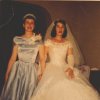 John was only in Philadelphia for a short time when one of his friends fell in love with a girl who worked in their office. John was to be Best Man at the wedding. The friend and his fiance arranged a blind date for John and one of the girls in the wedding party. Thus began the whirlwind romance between John Hamill, then 26, and Cindy Antrasian, age 17. Within three weeks John confessed his love, and within five weeks they were engaged. John and Cindy were married on September 7, 1957. Agnes Hamill and Cindy at the morning of Cindy and John's wedding.
John was only in Philadelphia for a short time when one of his friends fell in love with a girl who worked in their office. John was to be Best Man at the wedding. The friend and his fiance arranged a blind date for John and one of the girls in the wedding party. Thus began the whirlwind romance between John Hamill, then 26, and Cindy Antrasian, age 17. Within three weeks John confessed his love, and within five weeks they were engaged. John and Cindy were married on September 7, 1957. Agnes Hamill and Cindy at the morning of Cindy and John's wedding.John and Cindy have two sons, Brian Hamill born December 2, 1960, and Andrew Hamill born February 27, 1968. John Hamill became a citizen of the United States in 1962.
Jim Hamill
Jim Hamill was the youngest of the Hamill children. He was known as a the "Brainey" kid in the neighborhood. He attended "Wee" St. Johns, Big St. Johns and St. Columba's schools like his siblings. His sister Agnes, rememberd that Jim was always the quiet, smart kid who came up with lots of "ideas". He wanted to be a doctor when he grew up.
Agnes related the story of Jim ditching school because he was being picked on by a teacher. He either missed the first day of class, or there simply were not enough books to go around. Either way, he would get "the belt" every day from the notorious teacher Sam Sweeney (Sweeney Todd), for not having his book. Instead of running wild, like many 13 year old boys would have, Jim went to the library and spent his day reading books.
Agnes giggled as she related another story about Jim, "the idea man" and "Truent Books". These books were for kids who ditched school. Every day they were signed by the Head Master to prove that they had been to school. Jim had figured out that all he had to do was sign "J. Harvey", the Head Master's name in his classmates books and off they would go for the day. But, the Head Master's name was actually Frank Harvey. He got in big trouble for this one. Jim left school at age 14 to serve a 5 year apprentiship as a plummer in the shipyard.
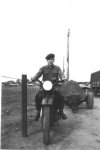 When he was 21, Jim entered the army for his required 2 year service.
When he was 21, Jim entered the army for his required 2 year service.





Agnes Hamill
Born on November 1, 1930, her early life is described above. At age 12, Agnes broke her leg rollerskating. A week after the cast came off, she was rollerskating and broke it again. The doctor would not let her go to school which resulted in her missing exams and ending up in the next year's class. At 14, Agnes left school to work in Clark's thread mill in Paisley. Agnes would take the train 5 days a week, leaving at 6:40 am and returning at 6:20 pm.She worked there until she was 19 in the embroidery thread area. Machines wound the floss around the cards, then there were some women who would put the labels on. Agnes' job was to pack the boxes with the finished product. 24 to a box, three rows of eight. This was piece work which was "stressful". The ladies she worked with gave her a hard time for being too "fussy" in packing the boxes.
Agnes had really wanted to persue a career in nursing, but the pay was so poor for student nurses that there was no way you could live on it, and her family was in no position to help her. After national healthcare came in, the pay for student nurses was doubled and it became possible. In 1950, Agnes took the enterace exam and was accepted in the Royal Alexandra Infirmary in Paisley. She began the three year program on June 1 . At the time, the student nurses lived in the hospital residence. Her mother was very proud that Agnes was "getting out" and not spending her life in the mill, but thought she would only last a month around blood.
While a student, she got 1 and a half days off a week. Agnes would go home. Duties and experiences. About mid way through the training, her father Jim Hamill got sick with lung cancer. He was ill about 6 months to a year before he passed.
 On April 6, 2001, Agnes Hamill Wunderlich sent me this brief bio: "Born in Port Glasgow in 1930, second of four
children all born during the
Depression.Father was a 'holder-on' in the
shipyards. Both parents were
orphans, father grew up with cousins. Mother was
one of four children, grew
up with various relatives, and three older siblings
were all placed in
orphanage. She never met her sister who
apparently died in her teens, and
her two brothers went straight from the orphanage
into the army. She met
one of her brothers prior to her marriage, but lost
touch and they did not
meet again till they were in their 40's. With
this background, not
surprising that my mother brought us up to be
independent - I think she
needed to know that we knew how to survive if
anything happened to her.
Her father took off and left the children when her
mother died when my
mother was 3 - 4 months old. I attended St John's
School in Port Glasgow,
then St Columba's in Greenock. I left school at
14, went to a commercial
college and didn't learn a thing! I never
mastered shorthand, and can
barely type today. I went to work at Clark's
Thread Mill in Paisley. I
really didn't enjoy working there and left after
two years to try to get
another job. No success there, so went back to
work in the thread mill for
another two years.
On April 6, 2001, Agnes Hamill Wunderlich sent me this brief bio: "Born in Port Glasgow in 1930, second of four
children all born during the
Depression.Father was a 'holder-on' in the
shipyards. Both parents were
orphans, father grew up with cousins. Mother was
one of four children, grew
up with various relatives, and three older siblings
were all placed in
orphanage. She never met her sister who
apparently died in her teens, and
her two brothers went straight from the orphanage
into the army. She met
one of her brothers prior to her marriage, but lost
touch and they did not
meet again till they were in their 40's. With
this background, not
surprising that my mother brought us up to be
independent - I think she
needed to know that we knew how to survive if
anything happened to her.
Her father took off and left the children when her
mother died when my
mother was 3 - 4 months old. I attended St John's
School in Port Glasgow,
then St Columba's in Greenock. I left school at
14, went to a commercial
college and didn't learn a thing! I never
mastered shorthand, and can
barely type today. I went to work at Clark's
Thread Mill in Paisley. I
really didn't enjoy working there and left after
two years to try to get
another job. No success there, so went back to
work in the thread mill for
another two years.When I was a child I always thought I'd be a teacher when I grew up, then when I was in hospital at the age of twelve, decided I'd like to be a nurse. So I worked in a mill, but my mother was very ill when I was 17, and i was again bitten by the nursing bug. I felt so helpless when she was lying in bed with tubes from every orifice, so it seemed, and I felt if I was a nurse I'd know what to do. I set out to find out how to become a nurse, but at that time the salary was about 100 pounds/year, and my family was not in a position to help me financially, so I didn't mention it to anyone. A couple of years later the NHS was introduced, the salary doubled, and I applied to, and was accepted by, the Royal Alexandria Infirmary, Paisley. I was 19 by this time, and I will say that the next three years were the happiest I had known. I loved nursing from the first day and was excited about all the new things I was learning. The social life was good too, because guys like student nurses! After graduation I did a post graduate course in neurological and neurosurgical nursing in Edinburgh. Enjoyed that too. Worked in local hospital for awhile, then did 6 months of OB which I didn't like one bit! No mystery, you knew what the diagnosis was as soon as you saw the belly.
From the time I knew there was a place outside Port Glasgow, I wanted to go see it. Dreamed of places like France and Italy, but could never get the money together to travel further than Glasgow except for cycling trips to stay in Youth Hostels. Decided I'd have to emigrate to raise the money to see Europe. Thought of Canada, Australia, New Zealand, and the USA. Seemed like most of the expatriots who came back to visit were either from Canada or the US, so seemed as tho these were the places it was easiest to save your fare home from! Mount Sinai Hospital in Cleveland were in Scotland recruiting, offered the best salary, advanced the airfare, and seemed like the best all round deal. That's how I arrived in the new land with $64 to my name. I did not mean to emigrate, just came here to raise the money to see Europe. I was 26 when I came to the US, but had sense enough to know I could never settle in Scotland until I travelled outside it.
I had a very busy social life (the Scots accent attracts men like flies) liked my job, but when I was 32 was finally ready to settle down. I had been dating a civil engineer for about a year, and he asked me to marry him. We were engaged for 9 days and married on my first day off after he popped the question. As I said, I was now ready to settle down! I got pregnant right away, and had three children in 23 months. My husband went to work for one of the oil companies, and we started travelling overseas when my children were under 3, under 2, and under 1 year old. Lived in England, Zaragoza(Spain) The Hague, and Madrid. They were 5, 6 and 7 years old when we returned to the US. Settled in Illinois, and have been here for 30 years. Child #4 was born in 1974, and we had waited so very long for him.
I was divorced in 1981, and after being at home for 18 years, went back to work. Enjoyed nursing as much as ever, and became a Certified Oncology Nurse. Continued working past retirement age, but after my first grandchild was born I retired from working and became part time caregiver for my grand daughter, to allow my daughter to work from home. I now have a grandson, so REALLY have to work.
I'm fortunate that my daughter lives only a few blocks from me, my youngest son still lives at home (not that he's here much!) and my two older sons are married but only live about one hour away from me, so we all get to see each other most weekends.
Things haven't always gone smoothly, but I'm very content now and like my life, and love my family."